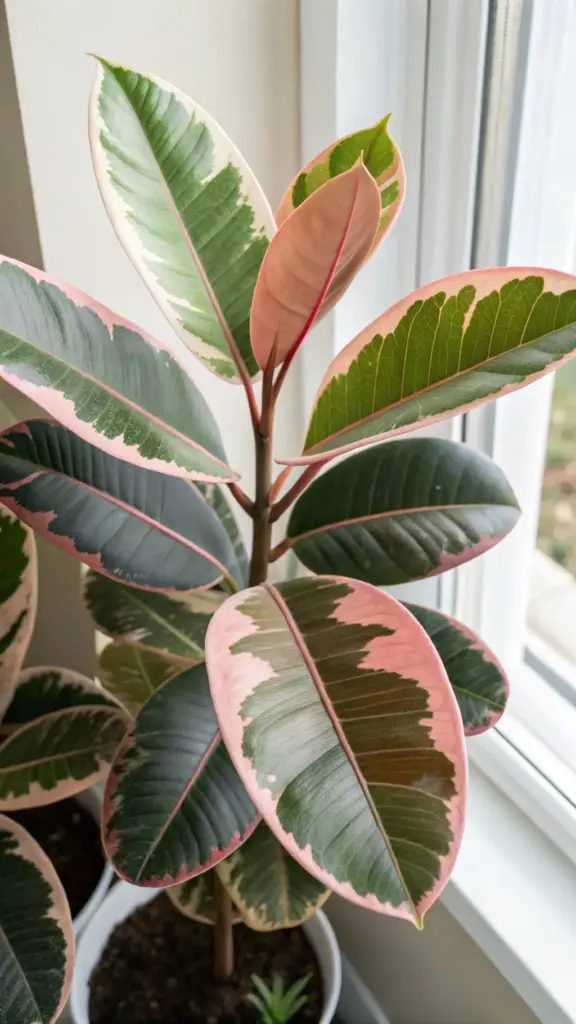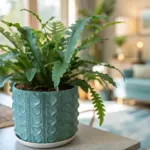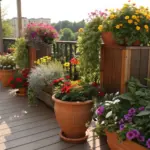4. Ficus elastica ‘Belize’ – The Tricolor Wonder

The first time I saw a Ficus elastica ‘Belize’ on Instagram, I thought it was heavily filtered. No way could a plant have that many colors naturally, right?
Wrong! When I finally got my hands on one at a plant show in Chicago, I couldn’t stop staring at it. This plant literally has three distinct colors dancing across every single leaf.
Understanding Those Mind-Blowing Variegation Patterns
The three-toned variegation on ‘Belize’ is absolutely incredible – we’re talking cream, green, and pink all on one leaf. It’s like nature decided to show off with this particular variety.
Variegation patterns aren’t random either. The cream sections typically appear along the leaf edges, while the pink coloration concentrates near the midrib and newer growth areas.
What makes this plant so special is that the three colors blend seamlessly into each other. You don’t get harsh lines – instead, it’s this gorgeous gradient effect.
Sectoral variegation means some leaves might be predominantly one color while others show all three tones. I’ve counted leaves on my plant with five different color variations – it’s wild!
The pink intensity varies dramatically based on growing conditions. Some leaves have just a blush of pink, while others are practically hot pink.
Light Requirements That Make or Break the Colors
Here’s where I messed up initially – I didn’t give my ‘Belize’ enough light to maintain those vibrant colors. The pink just faded to pale cream within weeks.
Bright, indirect light for 6-8 hours daily is absolutely crucial for maintaining vibrant colors. Without adequate light, you’ll lose that gorgeous pink coloration that makes this variety so special.
I’ve found that east-facing windows work perfectly because the morning sun brings out the pink tones without scorching the delicate variegated sections.
Light meters have become my best friend with this plant. I aim for 200-400 foot-candles throughout the day to keep those colors popping.
Too much direct sun bleaches the cream sections and can cause the pink areas to turn brown. It’s a delicate balance that took me months to figure out.
Grow lights work great as supplemental lighting during winter months. I use a full-spectrum LED positioned about 18 inches away.
Watering and Humidity Secrets
The watering schedule for ‘Belize’ is trickier than regular rubber plants because of all that variegation. Variegated sections have less chlorophyll, so they’re more sensitive to both over and under-watering.
I stick to the top 2-3 inches dry rule, but I check more frequently than with my other plants. The variegated areas show stress faster than solid green sections.
Humidity preferences are definitely on the higher side – I aim for 50-60% relative humidity. Lower humidity causes the leaf edges to crisp, especially those delicate cream sections.
My humidity setup includes a large pebble tray and a small humidifier that runs during dry winter months. The investment in proper humidity control really pays off with color retention.
Distilled water has made a huge difference in preventing brown spots on the variegated areas. Tap water minerals seem to accumulate in the lighter sections.
Companion Plants That Create Magic
Styled arrangements with ‘Belize’ are all about complementing those incredible colors without competing. I’ve learned that less is definitely more with this showstopper.
My favorite companion plant combo includes a deep green Monstera deliciosa and a cream-colored Pothos ‘Marble Queen’. The color harmony is absolutely perfect – the ‘Belize’ becomes the focal point.
Philodendron ‘Pink Princess’ works surprisingly well because it echoes the pink tones without overwhelming the space. Just make sure the ‘Belize’ gets the prime lighting spot since it’s more demanding.
For modern arrangements, I pair it with architectural plants like snake plants or ZZ plants. The contrast between the bold variegation and solid green foliage creates incredible visual interest.
Planter coordination is key – I use neutral colors like white, cream, or soft gray to let the plant colors shine. Anything too colorful just creates visual chaos with this variety.
Photography Tips for Social Media Gold
Let me tell you about photographing ‘Belize’ plants – it’s both incredibly rewarding and frustratingly difficult. The colors can look completely different depending on lighting conditions.
Natural morning light gives the most accurate color representation. I take most of my plant photos between 8-10 AM when the light is bright but not harsh.
The pink coloration tends to photograph more intensely than it appears in person. I’ve learned to slightly reduce saturation in post-processing to keep things realistic.
Background choices make a huge difference with this plant. White or light gray backgrounds really make those three colors pop without distraction.
My favorite photography angle is slightly from above to capture the full leaf patterns. Side lighting brings out the texture and color variations beautifully.
Phone camera tips: Use portrait mode to blur the background and make the variegation the star. The depth of field effect really makes the colors jump off the screen.
Ready to discover a compact variety that’s perfect for smaller spaces but packs just as much color punch? Hit next to learn about the Ficus elastica ‘Melany’ – a dwarf beauty with deep burgundy new growth that transforms before your eyes!









GIPHY App Key not set. Please check settings